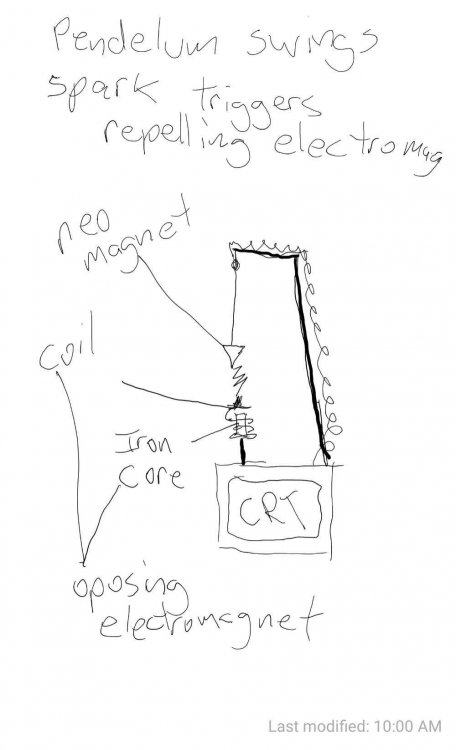-
Posts
107 -
Joined
-
Last visited
About emcelhannon
- Birthday 04/01/1969
Contact Methods
-
Website URL
element83.etsy.com
Profile Information
-
Location
Lexington KY
-
Interests
learning
-
College Major/Degree
masters...never mind what it's in
-
Favorite Area of Science
Quantum
-
Biography
40 yr old father of 4. A pretty hot wife. A small but classy home. Life is good
-
Occupation
Art Teacher, Science related artist at element83.etsy.com
Retained
- Meson
Recent Profile Visitors
The recent visitors block is disabled and is not being shown to other users.
emcelhannon's Achievements

Baryon (4/13)
28
Reputation
-

high power lead needs to power or trigger an electromagnet.
emcelhannon replied to emcelhannon's topic in Science Education
come on , guys -
emcelhannon started following high power lead needs to power or trigger an electromagnet.
-

high power lead needs to power or trigger an electromagnet.
emcelhannon replied to emcelhannon's topic in Science Education
My true goal is to make my son idolize me as mad scientist in the basement. It's an oddly compelling and enduring motivation. What about a mosfet. I want to power a pendulum with a magnet on the tip. The push will be a base electromagnet that triggers on when the pendulum reaches near equilibrium position. The high voltage lead will be connected to the pendulum. The switch will be the close proximity to ground which will be centered beneath. My goal is to create a nice arc at equilibrium position which will send power to the electromagnet. I thought it would be easy. The hv was suppose to actually power the electromagnet, but it's all volts and no amps, sort of. It's just hv art. Any help you can give me would be greatly appreciated. Many, many thanks, Ernie -

high power lead needs to power or trigger an electromagnet.
emcelhannon replied to emcelhannon's topic in Science Education
I want to keep it swinging with a little juice to the repelling electromagnet below it. I'll have an opposing pole facing down on the pendulum. The current from the high voltage lead isn't enough. I tried a neon sign transformer too. -

high power lead needs to power or trigger an electromagnet.
emcelhannon replied to emcelhannon's topic in Science Education
Thanks guys. What about powering a relay? I need the electromagnet to come on the moment the high voltage lead makes its spark. -
Hi, I'm trying to wire a circuit that will use the high voltage lead from an old crt to power an electromagnet. I'm getting no reaction from my coil...lots of juice, no magnetic field. Is it an AC thing? I thought the hp leads on crts were dc. Just in case I took a high voltage diode from a microwave and fit it in, but it made no difference. What are my options? Many thanks for your replies. Ernie
-
I want to give my diamagnetic projects more lift. It's the bismuth plates and 2 magnet arrangement. You can see mine here. The bismuth repels both north and south poles equally, but weakly. With a crown magnet pulling up on the tiny magnet just enough to let the bismuth push it into the air without getting it so close to the top magnet that it's drawn all the way up. Then the Ernshaw principle would take over. Here's the thing. I use a strong neo magnet, but Theo Grey uses a semi-complex arrangement of ceramic magnets. See his here. http://scitoys.com/scitoys/scitoys/magnets/suspension.html I'm wondering if a larger magnet with a weaker field will provide greater lift. I can't think of why. So, I'm wondering what magnetic arrangement would would give the greatest effect, maybe the one with the most spread out field. What do you guys think?
-
Hmmm, I was hoping for a cheap schematic using switches and diodes. Am I dreaming? E.
-
I always wanted to build simple drawers and tiny supply elevators that could open and close, (rise and decend) at the push of a button. Now I have several practical uses for a circuit like that, but I'm still stumped on how to wire one. What I'd like to replicate is the drawer of a cd drive. Push a button, and the drawer extends and stops. Push THE SAME button, and it recedes back into its box. What is the name for this kind of circuit, and can someone post or direct me to a schematic. There's no need to cover the mechanics of the belts and pulleys, and I'm working with D.C. motors. Many, many thanks, Ernie
-
Does activation of the charcoal make a difference? I often have black powder remaining. I assume this is mostly carbon. I don't fully understand mechanical activation, but I'm guessing I can continue to use my left over charcoal. Am I right? Many thanks, E.
-
How thick would the layer of bismuth oxide on pure Bi metal need to be to produce green, and what would the progression of colors be as the layer thickens? I think we would apply Fresnell's Equations, but I'm not sure how. The refractive index of Bi2O3 is 2.5/0.4 according to a Chinese distributor of the yellow powder form. I'm not sure if that applies on the thin oxide layer on pure metal. Many thanks to whoever can help me understand. Ernie
-
How about contamination by solder? I'm getting crystal growth, but it's all coming out silver, (no color). I'm guessing that the tin and other contaminates are floating to the top, and coat everything with a protective layer when I pour it. I jack up the heat and skim it throughout the day and have once been able to reclaim the remainder. Question. What is a better way to separate a large pot of Bi from small amounts of solder? Many thanks, Ernie
-
I've been mixing in the charcoal with scraps and oxidized bismuth, and putting an extra layer of charcoal on top. I haven't stopped to carefully weigh the results, but it seems to help. I haven't tried lye yet. Temperatures up to 700 f are easy. The oxidized metal seems to float to the top with the charcoal which is perfect since that's the combo I want. Small amounts of slag stick to the sides.
-
How hot do I need to get it? I'm trying to bond C to O, right?
-
Neighbors aren't a problem, and muratic acid is easy to find. Still, where would I buy sulfuric? What anode would you suggest? Thanks tons for your help! E.


